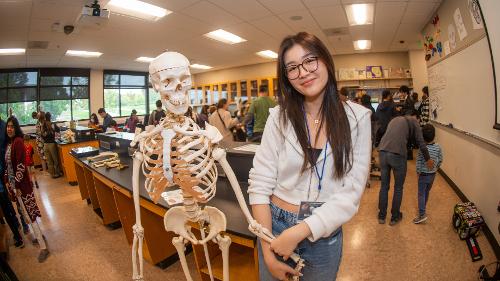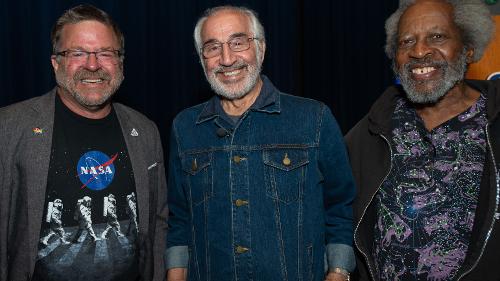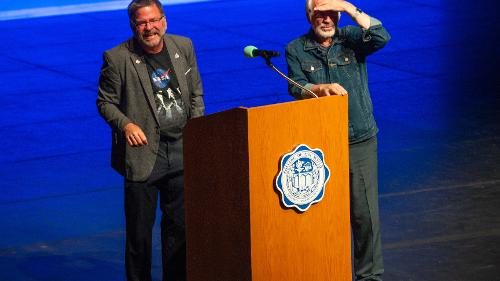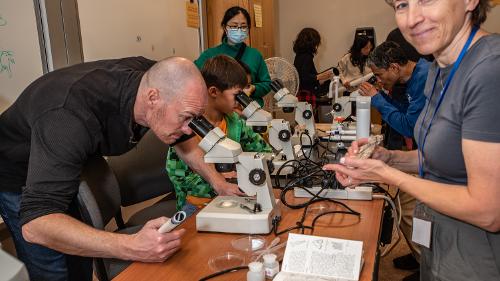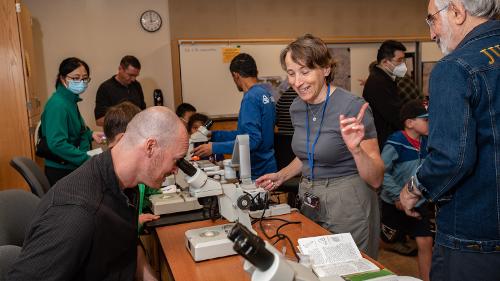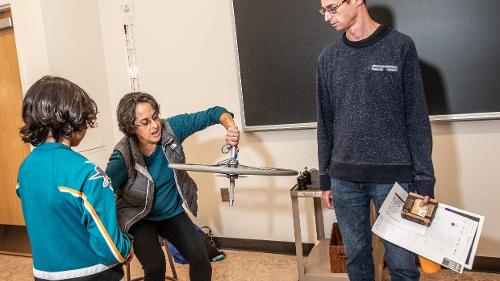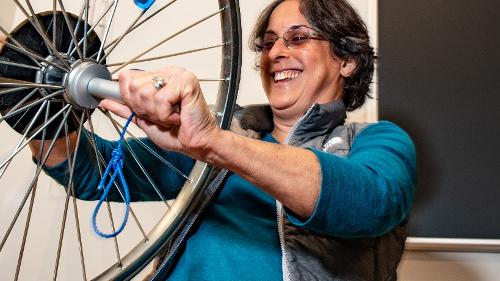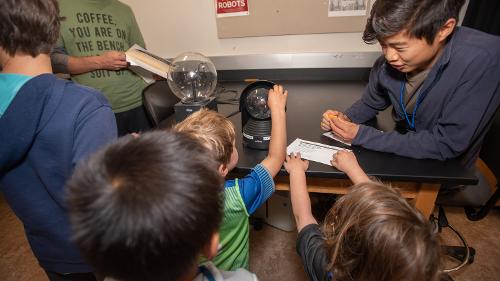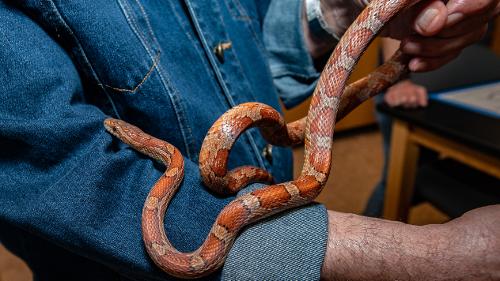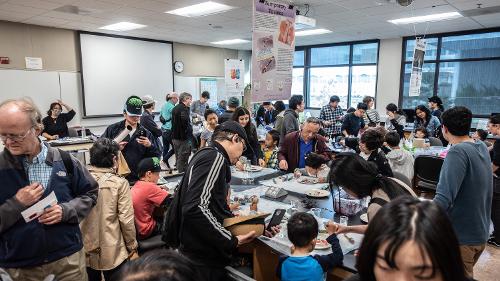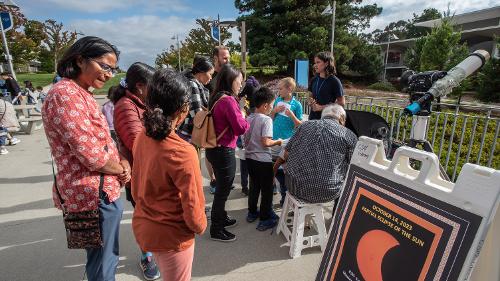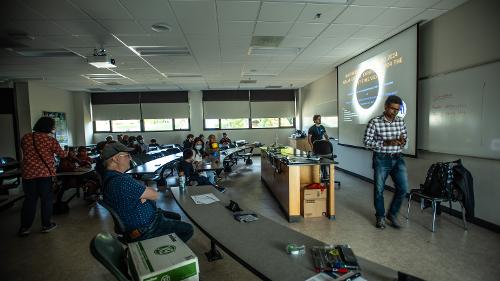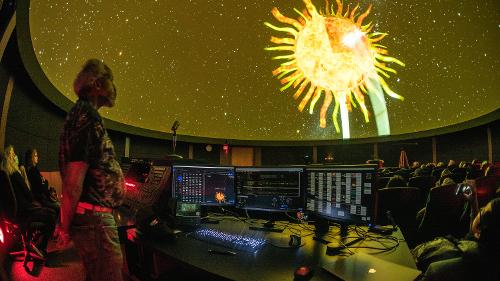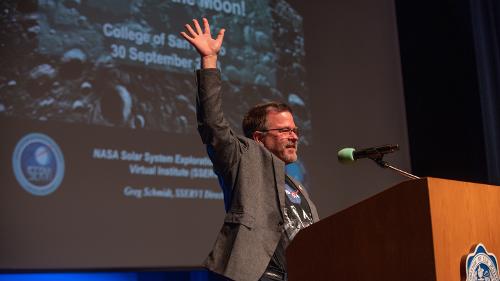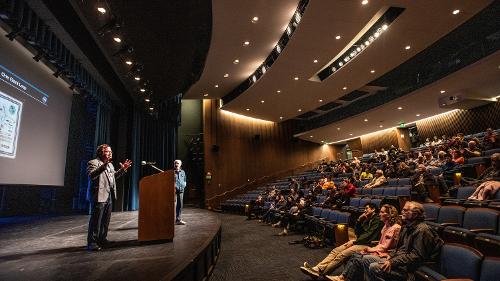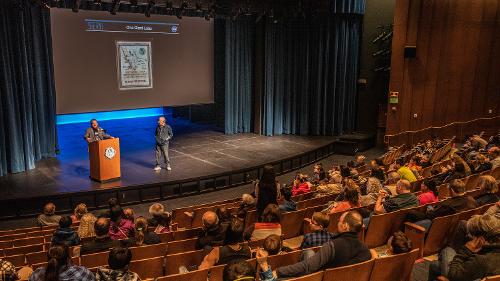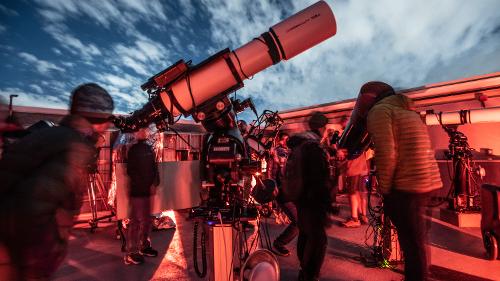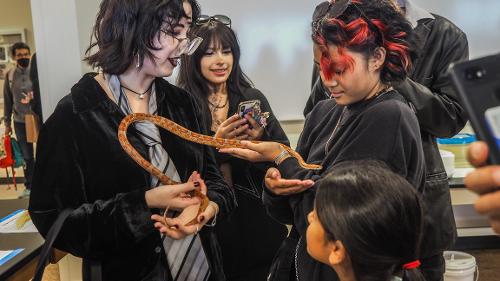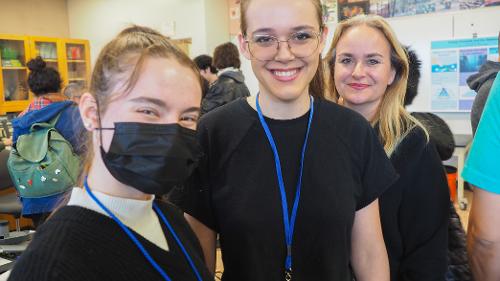Overview
Family Science Day
Saturday, September 27, 2025, 1-5 pm & 7-11 pm
Science Building 36 and Theatre Building 3
Join us for science workshops, planetarium shows, firefighter demonstrations and hands-on makerspace projects from 1-5 pm. At 7:30 pm, keynote speaker Dr. Pascal Lee will present “From the Moon to Mars,” followed by a reception, then star gazing from CSM’s rooftop observatory with live music.
Keynote Lecture
7:00 pm to 9:00 pm in the CSM Theatre Building 3
- 7:00 pm Doors Open
- 7:30 pm Lecture
- 8:30-9:00 pm Reception in the Theatre Lobby
9:15 pm to 11:00 pm at the CSM Science Building 36, Rooftop Observatory
- 9:15-11:00 pm Star Gazing on CSM's Rooftop Observatory with Live Music
From the Moon to Mars
Humans are heading back to the Moon and planning new journeys to Mars. Why are we going? How will we go? Where will we land? How will we explore these worlds? When are we going? Who will go? This talk will present the latest progress made in NASA's Artemis Program to return to the Moon and NASA's "Moon To Mars" plans beyond, China's own competing efforts, and our bright human future in space.
Keynote Speaker: Dr. Pascal Lee
Dr. Pascal Lee is a planetary scientist with the SETI Institute, the Mars Institute, and NASA Ames Research Center in Mountain View, California. He is also professor of planetary sciences at Kepler Space University, and chief scientist for Ceres Robotics, a NASA Commercial Lunar Payload Services (CLPS) industry provider. He also serves as the National Space Society’s Vice‑President for Planetary Development.
Dr. Lee holds an M.E. in geology from the University of Paris-Sorbonne, and a MS and PhD in astronomy and space sciences from Cornell University where he was Carl Sagan’s last teaching assistant. His research focuses on the Moon and Mars, and planning the future human exploration of these worlds. He recently co-discovered the Noctis volcano, an ancient giant volcano near Mars’ equator.

Dr. Lee has led over 30 expeditions to the Arctic and Antarctica to study Mars by comparison with the Earth. He wintered over for 402 days at Dumont d’Urville Station in Antarctica, and led the Northwest Passage Drive Expedition – a record-setting vehicular traverse across the Arctic along the fabled Northwest Passage. The epic journey is now the subject of the award-winning motion picture documentary film, Passage To Mars.
Dr. Lee is currently a member of the US National Academies’ steering committee on “A Science Strategy for the Human Exploration of Mars.” He is a recipient of the United States Antarctica Service Medal, the National Space Society Space Pioneer Award for Science and Engineering, the Space Frontier Foundation’s Vision to Reality Award, and the Sagan Prize for the Popularization of Science.
In his free time, Pascal likes to be walked by his dog Apollo, fly, and paint. He is an FAA-certified helicopter commercial pilot and flight instructor. His oil paintings on Mars exploration and spacetime travel are in collections worldwide.
Science Workshops
All science workshops are open from 1 pm to 5 pm and walk-in (anytime), unless otherwise indicated.
|
Presenter(s) |
Workshop |
Activities |
Location |
|---|---|---|---|
|
Alex Wong |
Phabulous Physics |
Sparks fly as we discover phenomena of electricity, magnetism, light, and motion. |
Bldg. 36, Rm.114 |
|
Katryn Wiese (CSM) |
Earth Rocks! Let’s Explore It |
Explore a variety of maps, rocks, minerals, and fossils and discover what they tell us about Earth's past, present, and future. |
Bldg. 36, Rm.119 |
|
Krista Bailey, Javier Silva |
Interactive Anatomy Museum |
Come and explore the amazing world of human anatomy and physiology through hands-on activities and by observing displays with models and real human organs. Immerse yourself in our one-of-a-kind museum that focuses on human anatomy. Enjoy interactive displays showcasing detailed models and real human organs. |
Bldg. 36, Rm.217 |
| Faculty (CSM) |
Hands-on Fun with Biology and Chemistry |
Color Awesome is a chemistry workshop that shows you fun experiments using everyday household items. You’ll get to create colorful patterns with chromatography and watch the rainbow effect with acids and bases. The Biology Hands-On Museum is a fun, interactive exhibit where you can build and take home a virus model and learn about some fascinating animals. |
Bldg. 36, Rm.200 |
|
Christy Baird (CSM) |
A Day in the Life |
Who doesn't love firefighters? Come see the College of San Mateo Fire Technology students in action as they demonstrate their skills! Learn some fire safety tips and what being a firefighter on a call is like. You can even join the CSM firefighter cadets to squirt some water. 3 to 4 pm. |
Plaza of the Sun |
|
Loki Ingalls (SMCAS) |
Comet Chef |
The Comet Chef will make a miniature of a comet’s nucleus using common household materials. The demonstration will take about 5-10 minutes and is designed to fit in-between Planetarium Shows. |
Planetarium Patio (on north side of Bldg. 36) |
|
Michael Cooke (SMCAS) |
Sun Solar System Model |
Join us for an amazing, up close look at a model of the inner solar system. It will demonstrate the vast distances between (and the tiny size of) planets relative to a one-meter Sun. |
Bldg. 36, Bridge |
|
Channan Greenberg |
Ken Lum Solar Workshop |
Observe the sun safely through Ken Lum’s solar telescope. Conditions permitting, see solar flares, prominences, and sunspots. |
Bldg. 36, Bridge |
|
Ed Ching |
Making Planisphere |
Construct your own planisphere, a device for finding your way through the stars in the night sky. |
Bldg. 36, Rm.112 |
|
Marion Weiler |
How a Telescope Works |
How do telescopes gather and manipulate light to bring distant and dim astronomical objects such as the moon, planets, and galaxies into clear focus for our viewing? Interactive demonstration on how telescopes work. |
Bldg. 36, First Floor Lobby |
|
Xinnan Du |
Build Your Own Pulsar |
Build and take home a pulsar model made of LED lights and play-doh! Join us and learn how these compact objects form in the universe and why they are interesting to study. |
Bldg. 36, Rm.109 |
- San Mateo County Astronomical Society (SMCAS)
- Kavli Institute for Particle Astrophysics & Cosmology (KIPAC)
Planetarium Shows
The planetarium shows run 1 pm to 5 pm on the hour. Obtain tickets at the planetarium entrance.
Makerspace Workshops
All Makerspace workshops are open from 1 pm to 5 pm and walk-in (anytime) in Bldg. 36, Rm. 125.
|
Presenter(s) |
Workshop |
|---|---|
|
Yoram Savion |
Lego Robotics workshop (3-5 pm) |
|
Tun Thiri May |
Face Painting |
|
CSM Library & Makerspace Team |
Vintage Typewriters |
| CSM Library & Makerspace Team |
Make Your Own Buttons |
| CSM Library & Makerspace Team |
Fun Stations - Jumbo Jenga & Coloring |
| CSM Library & Makerspace Team |
3D Printer Demo |
CSM Library & Makerspace Team: Valeria Estrada, Carlos Bugarin Camacho, Alejandro Hernandez, Tun Thiri May, and Student Volunteers
- Sponsored by the San Mateo County Astronomical Society (SMCAS) and CSM’s Math, Engineering, Science Achievement Program (MESA)
- Supported by CSM's Title V Grant for Developing Hispanic Serving Institutions
Family Science Day Photo Gallery
November 10, 2025
November 27-28, 2025
December 9-15, 2025

